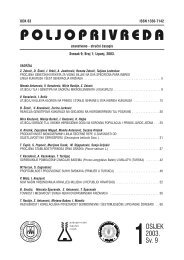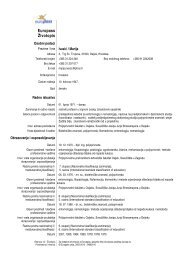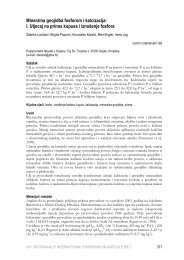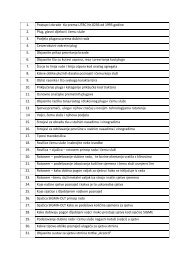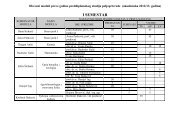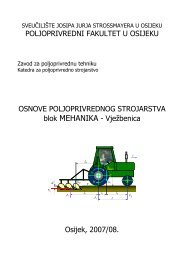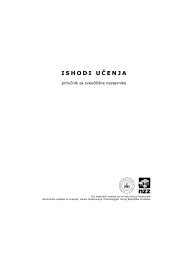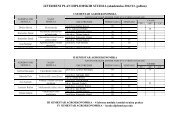Poljoprivreda 2-2006 final.qxd
Poljoprivreda 2-2006 final.qxd
Poljoprivreda 2-2006 final.qxd
Create successful ePaper yourself
Turn your PDF publications into a flip-book with our unique Google optimized e-Paper software.
D. Ivić i sur.: DINAMIKA I INTENZITET RAZVOJA BOLESTI NA JABUCI TIJEKOM SKLADIŠTENJA<br />
41<br />
10. Shi, Y. L., Correll, J. C., Guerber, J. C. (1996): Frequency<br />
of Colletotrichum causing bitter rot of apple in the southeastern<br />
United States. Plant Disease 80, 692–696.<br />
11. Snowdon, L. A. (1990): A Colour Atlas of Post-Harvest<br />
Diseases and Disorders of Fruits & Vegetables. Wolfe<br />
Scientific Ltd, London.<br />
12. Taylor, J. (1971): Epidemiology and Symptomatology of<br />
Apple Bitter Rot. Phytopathology 8, 1028–1029.<br />
13. Tronsmo, A., Raa, J. (1977): The life cycle of the dry eye<br />
rot pathogen Botrytis cinerea Pers. on apple. Phytopathologische<br />
Zeitscrhift 89, 203-207.<br />
14. Van Leeuwen, G. C., Stein, M., Holb, I., Jeger, M. J.<br />
(2000): Yield loss caused by Monilia fructigena in Dutch<br />
orchards. European Journal of Plant Pathology 75, 534-<br />
432.<br />
15. Xu, X.-M., Robinson, J. D. (2000): Epidemiology of brown<br />
rot (Monilinia fructigena) on apple: infection of fruits by<br />
conidia. Plant Pathology 49, 201-207.<br />
DYNAMICS AND INTENSITY OF APLE DISEASE DEVELOPMENT DURING<br />
ITS STORAGE<br />
SUMMARY<br />
Post-harvest apple fruit diseases are primarily caused by fungi. The object of this research was to quantify<br />
yield loss caused by post-harvest diseases and to determine fungal species responsible for storage rots on<br />
the cv. Idared during three months of storage, as well as to compare the development of fungi inoculated on<br />
apple fruits in the laboratory conditions. Only fruits with the visible rot symptoms were regarded as “diseased”.<br />
Total yield loss during all three months of storage was 1.9%. The percentage of diseased fruits increased<br />
from the harvest moment to the end of storage. The most frequent cause of post-harvest rot in all assessments<br />
was Monilia fructigena. Penicillium species and Botrytis cinerea were present in relatively high percentage.<br />
All fungal isolates from diseased fruits caused fruit rot when inoculated on apples and incubated for 28 days<br />
at 22°C. On fruits inoculated with the same isolates and incubated at 4°C rot development was slower. Isolates<br />
of M. fructigena developed most rapidly on inoculated fruits at 22°C, while the isolates of B. cinerea developed<br />
most rapidly at 4°C.<br />
Key-words: apple, post-harvest diseases, fruit rot<br />
(Primljeno 18. srpnja <strong>2006</strong>.; prihvaćeno 31. listopada <strong>2006</strong>. - Received on 18 July <strong>2006</strong>; accepted on 31 October<br />
<strong>2006</strong>)<br />
POLJOPRIVREDA 12:<strong>2006</strong> (2) 36-41



